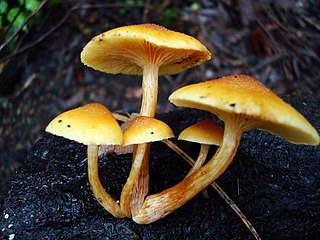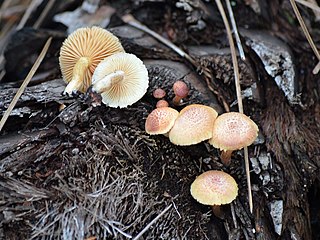
Gymnopilus junonius is a type of mushroom-forming fungus in the family Hymenogastraceae. Commonly known as the spectacular rustgill, this large orange mushroom is typically found growing on tree stumps, logs, or tree bases. Some subspecies of this mushroom contain the neurotoxic oligoisoprenoid gymnopilin.

Gymnopilus is a genus of gilled mushrooms within the fungal family Hymenogastraceae containing over 200 rusty-orange spored mushroom species formerly divided among Pholiota and the defunct genus Flammula. The fruit body is typically reddish brown to rusty orange to yellow, medium to large, often with a well-developed veil. Most members of Gymnopilus grow on wood but at times may appear terrestrial if the wood is buried or decomposed. Members of Pholiota and Cortinarius are easy to confuse with Gymnopilus. Pholiota can be distinguished by its viscid cap and duller spores, and Cortinarius grows on the ground. Beginners can confuse Gymnopilus with Galerina, which contains deadly poisonous species.

Gymnopilus luteofolius, known as the yellow-gilled gymnopilus, is a large and widely distributed mushroom that grows in dense clusters on dead hardwoods and conifers. It grows in late July to November in the east and in the winter on the west coast of North America. It has a rusty orange spore print and a bitter taste.

Gymnopilus purpuratus is a species of agaric fungus in the family Hymenogastraceae. It grows in clusters on dead wood, tree stumps and wood chip mulch. It is widely distributed and has been recorded in Argentina, Australia, Chile, New Zealand, the UK and Germany. It has a broadly convex cap covered in small dry reddish-brown scales, a stout yellow stem beneath reddish brown, wine-red to purple vertical fibres, and a thick rusty orange spore print.

Gymnopilus sapineus, commonly known as the scaly rustgill or common and boring gymnopilus, is a small and widely distributed mushroom which grows in dense clusters on dead conifer wood. It has a rusty orange spore print and a bitter taste. This species does not stain blue and lacks the hallucinogen psilocybin.

Gymnopilus viridans is a mushroom in the family Hymenogastraceae. It contains the hallucinogens psilocybin and psilocin. It is a rarely documented species, the last known collection being from the US state of Washington in 1912.

Gymnopilus luteoviridis is a widely distributed mushroom-forming fungus of the Eastern United States that contains the hallucinogens psilocybin and psilocin.
Gymnopilus armillatus is a species of mushroom-forming fungus in the family Hymenogastraceae.
Gymnopilus areolatus is a species of mushroom-forming fungus in the family Hymenogastraceae. It was first formally described by American mycologist William Alphonso Murrill, from specimens collected in Cuba.

Gymnopilus dilepis is a species of mushroom in the family Hymenogastraceae. This species is found in India, Malaysia, and North America. It was given its current name by mycologist Rolf Singer in 1951. It contains psilocybin and related hallucinogenic substances.
Gymnopilus hispidellus is a species of mushroom in the family Hymenogastraceae.
Gymnopilus medius is a species of mushroom in the family Hymenogastraceae.

Gymnopilus subtropicus is a species of agaric fungus in the family Hymenogastraceae.
Gymnopilus subearlei is a species of mushroom-forming fungus in the family Hymenogastraceae.
Gymnopilus subbellulus is a species of mushroom-forming fungus in the family Hymenogastraceae.
Gymnopilus rufobrunneus is a species of mushroom-forming fungus in the family Hymenogastraceae.
Gymnopilus pulchrifolius is a species of mushroom in the family Hymenogastraceae. It was given its current name by American mycologist Murrill in 1917.
Gymnopilus pholiotoides is a species of mushroom in the family Hymenogastraceae.

Gymnopilus imperialis is a species of mushroom in the family Hymenogastraceae. It was given its current name by mycologist Rolf Singer in 1951.

Gymnopilus palmicola is a species of mushroom in the family Hymenogastraceae.











